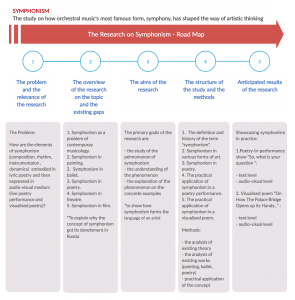Developing the theoretical framework
Symphonism, the theoretical framework of my research (to put it simply, ‘conversations with symphonism’), is where I discuss and evaluate the theories that are most relevant to my research.
The main goals of this ‘theoretical thread’ are to:
1. Define key concepts
2. Evaluate and combine relevant theories.
3. Try out those theories in practice and explain the assumptions and expectations that guide the research.
By presenting this information on symphonism, I ‘frame’ my research and justify my approach by showing that the point of departure of my work is established ideas.
This part of my dissertation lays the foundations that will support my analysis and practical implementation of theories, allowing me to convincingly interpret the results and explain their broader relevance.
Preface
I am trying to think out loud about how orchestral music’s most famous form has shaped the way of artistic thinking (be it in music, poetry, painting, theatre or ballet) by examining a few art works and digesting dozens of many more that I think are responsible for telling us most about how the method of symphonism has been implemented by various artists, and how it changed the world outside La Scala.
One of the questions of many poets is the formation of a poetic thought, its development and transformation into form. In this work I will talk about “symphonism”. In Soviet and post-Soviet musicology, in a broad sense, symphonism is interpreted as a philosophical and dialectical reflection of reality in a work of art [1], in a narrowest sense, as a method of creating musical works based on a deep and comprehensive disclosure of the artistic idea, dramaturgy [2]. “Symphonism” is a Soviet know-how, not widely used in foreign art criticism.
Throughout the research, I hope what will be proved is the sense that the implementation of the method of symphonism by artists isn’t simply about compositional technique or artistic experimentation, but about the way they think about themselves and their place in the world.
Some of the readers might get sceptical about the relevance of symphonism in our present-day post-symphonic age. They would appeal to the idea that a symphonic frame of mind, structured, ordered, layered, doesn’t fit with our more fractured post-modern mindset. However, what is mostly observed in the symphonies of the previous centuries is exactly what we face now: the urge to create some kind of order from chaos.
Another subject matter I hope we’ll pick up along the way: the paradox of multilayerdness of symphonism. There is an astonishing range of manifestations of symphonism in various works of art that we can all experience and learn from. Types of symphonism are due to historical time and the context of the author. Symphonism isn’t a fixed method of composing an art work so much as a continuously evolving organism of musical thinking that only gets richer and richer each time it’s implemented and thought about by the author.











